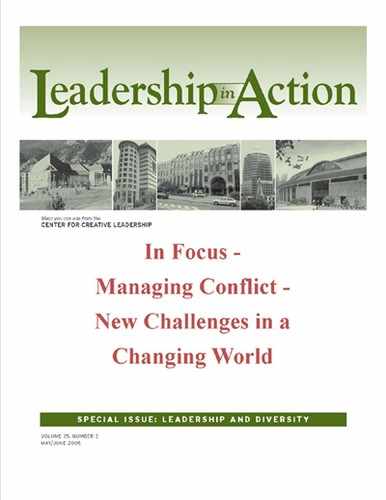In Focus/Managing Conflict: New Challenges in a Changing World
Kelly Hannum and Todd Weber
Globalization, technological developments, and increased immigration are changing workforce demographics around the world. Creating, developing, and distributing goods and services in a global economy often requires employees from a variety of backgrounds to work together effectively. In nearly every country, tensions and conflicts have occurred between social identity groups, which are defined by categories (or a combination of categories) such as gender, age, ethnicity, race, religion, nationality, sexual orientation, and socioeconomic status. When these tensions and conflicts, often originating in society at large, spill over into the workplace, they place an unprecedented demand on leadership. In a progressively interdependent and diverse world, a major leadership challenge will increasingly be the need to lead groups of people with very different histories, perspectives, values, and cultures toward a common purpose.
Dealing with social identity–based tension and conflict is challenging because the meaning of specific actions is highly dependent on context and often laden with emotions. A particular action or behavior by an individual may have one meaning for members of that individual's social identity group and an entirely different meaning and significance for members of a different group. For example, members of one social identity group might ignore a behavior by a member of their group, whereas members of a different group may feel the behavior requires a stronger response.
Social identity–based tension may be experienced at both the individual and the organizational levels. Individuals may feel their core values and beliefs are being challenged. Organizations may find that policies and procedures that have served them well no longer address critical issues in a more diverse workplace.
To illustrate the challenges of dealing with social identity conflict, consider a situation in a manufacturing plant where a member of the dominant religious group wears a provocative T-shirt that highlights his religious identity at the expense of others' identities. Nonbelievers and workers of other faiths take offense and complain about the T-shirt. The worker's supervisor privately asks him not to wear the T-shirt to work again, and assumes that the problem has been resolved. That may be the case in a workplace characterized by trust and understanding, where the T-shirt may not produce strong reactions but may be viewed simply as the inappropriate act of one individual. But in a workplace experiencing intense and ongoing religious tension, the T-shirt incident may contribute to a cumulative perception of inequality and lack of respect felt by employees who do not belong to the dominant faith.
CCL researchers are conducting a project called Leadership Across Differences, which is designed to generate new knowledge, techniques, and tools to help leaders deal effectively with the challenges associated with social identity differences in the workplace. This research is uncovering information that can help leaders make sense of and navigate changing conditions and expectations in an increasingly complex and global environment. Although the project is still in process, it has identified some preliminary themes that provide food for thought.
The ability to understand multiple perspectives, including one's own, is an important aspect of leadership. Developing the capacity to detect and understand differences in outlook can be difficult for leaders, however, particularly for those who are members of a dominant identity group. Such leaders are far less likely to directly experience tensions and conflicts with the same force and significance as do leaders who are members of a nondominant identity group. CCL's researchers have seen numerous cases in which members of the dominant and nondominant identity groups have viewed the seriousness of an incident differently. A leader who is a member of the dominant group may not fully appreciate how strongly the offended group feels about a situation, and this lack of awareness often comes across to those in the nondominant group as indifference. To overcome this challenge, leaders can cultivate an atmosphere in which members of nondominant groups feel comfortable communicating concerns related to social identity tension.
New Challenges in a Changing World
In times of substantial social identity tension caused by a specific incident, one simple action that appears to be effective is an apology. A sincere apology acknowledges the experience an individual or group is having, whereas ignoring a situation can make an individual or group feel marginalized and slighted. Such apologies should be attempted only when they are sincere, however, because insincere apologies may further exacerbate conflict.
The Leadership Across Differences project will continue to improve our understanding of how organizations respond when social identity conflict emerges, knowledge that has significant implications for leading effectively in an increasingly diverse workforce. ![]()
Editor's note: In Focus is an occasional series that takes close looks at specific topics of importance to leadership and leaders.
Kelly Hannum is an enterprise associate at CCL. She holds a Ph.D. degree from the University of North Carolina at Greensboro. Todd Weber is a research intern at CCL. He holds a Master of Organizational Behavior degree from Brigham Young University.
